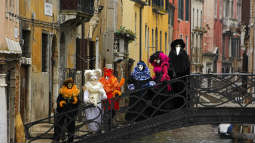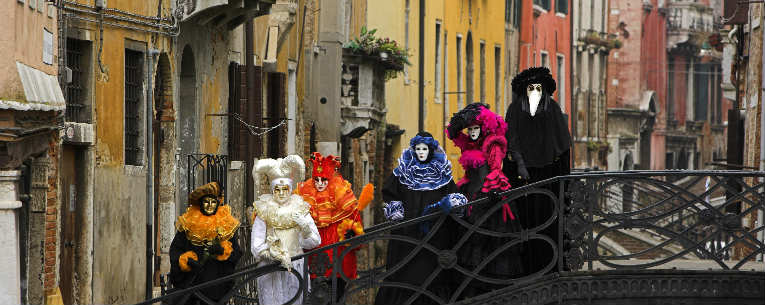Carnival is more than just a festival. This ancient practice arose in Catholic nations to celebrate the last days of fun and feasting before the solemn observance of Lent.1 Today, Carnival has become a wild and colorful spectacle, from Venice to Trinidad to Rio. The beauty of Carnival is that no matter where in the world you are, it’s not something you just watch. Everyone is a participant.
It’s not always easy traveling for Carnival. Hotels fill up fast. Everything gets more expensive. And crowds are a given. But if you’re willing to join the party, a once-in-a-lifetime experience awaits. Where should you go to celebrate?
If you don’t mind getting messy: Carnival in Trinidad and Tobago
Trinidadians kick off the party at 4 a.m. on the Monday preceding Ash Wednesday with a ritual called J’Ouvert, meaning “day opens.” It’s also called dutty mas because everyone covers themselves with mud, body paint or oils — and you’ll soon be covered, too.2 Another tradition is the “blue devils,” people painted blue and wearing devil masks who demand money from onlookers. Deny them, and they’ll rub against you so you’re blue, too.3 Dance along with rolling bands, drink and then head home around 10 a.m. to get cleaned up before the Monday carnival processions begin.
Tuesday Carnival in Trinidad is when elaborately costumed mas bands (short for masquerade) parade down the street to calypso and soca and compete for prizes. You can pay to join a band, which includes a costume, drinks, food, and mobile bathrooms. (If itty-bitty bikinis aren’t your thing, some bands wear more conservative, but no less colorful, costumes).4
If you’re all about the parades, not the parties: Carnaval de Nice
The city of Nice, on France’s Côte d’Azur, hosts an annual 12-day carnival with not one but several different parades, drawing more than a thousand performers and a million spectators. The floats are creative and often grotesque, centered on a theme that changes every year. You’ll see giant, animated puppets called grosses tetes, or “big heads,” plus costumed drummers and flashing lights.5
As fun as the floats are, the Nice Carnival is most famous for its Bataille de Fleurs, the Battle of Flowers. Regally gowned women stand on decorated floats and fling real flowers at the crowds. People compete to catch them. At the end of the parade, the flowers are plucked from the floats and handed out, so you can collect a huge bouquet.6 On the first Monday of the Nice Carnival, there’s also a naval flower battle, in which traditional fishing boats are bedecked with blossoms. The Carnival ends when an effigy of the Carnival King is burned and fireworks fill the sky.7
If you want to be part of an epic event: Carnaval in Rio de Janeiro
Gargantuan, ostentatious, extravagant: There aren’t enough big words to describe just how big Rio’s carnival is. Millions of people descend on the streets to dance, drink, dance some more and admire the elaborate costumes and floats in the samba school parade.
Carnival in Rio de Janeiro (Carnaval, in Portuguese) is an old tradition, introduced by Portuguese immigrants in the 18th century.8 Carnaval isn’t just a single massive celebration, but an assembly of hundreds of smaller ones called blocos. Blocos are street parties led by moving bands, some aboard trios eletricos, which are trucks equipped with amps and stages.9 The festivities culminate with a two-night competition at the Sambadrome, in which thousands of costumed dancers, representing the city’s top samba schools, compete. This is the iconic image of Carnaval in Rio: beautiful women in spangled costumes and enormous feathered headdresses.
As raucous as Rio’s Carnaval can be, it’s friendly, too: Don’t be surprised if someone presses a beer into your hand and offers to teach you a dance step.10
If you want a fairy tale experience: Carnevale in Venice
Venice’s carnival, the Carnevale di Venezia, is the oldest of them all. It traces its origins to 1162 when townspeople celebrated a military victory over the Patriarch of Aquileia.11 Later, people began wearing elaborate, beautifully crafted masks during Carnevale to conceal their identities during decadent pursuits. Traditional masks take several shapes, such as the cat-shaped Gatto, the long-beaked Dottore Peste (plague doctor), and the bejeweled Dama.12
To fully experience the Carnevale di Venezia, buy an authentic mask and a costume to go with it, then get tickets for one of the city’s grand masquerade balls. Dress codes are strict, ranging from elegant evening wear to full period costumes. If you’re reluctant to drop a thousand-plus euros on your ticket and costume, try a carnival pub crawl instead!13
If you want a family-friendly festival: Mardi Gras in Mobile
Few people know that in America, Mobile, Alabama, was the first city to celebrate Mardi Gras back in 1703. Mobile carries on the tradition to this day with lavish parades, the coronation of Mardi Gras kings and queens, and reveling in the streets. Mobile’s Mardi Gras is tamer than New Orleans’, however. While people are still carousing, there’s less naughty behavior; and kids will come away with armfuls of “throws” — the prizes flung from floats that include plush toys, beads and Moon Pies.14
In Mobile, the floats are created by mystic societies, similar to New Orleans’ krewes. The most famous is the Mystics of Time, which puts on a parade the Saturday before Mardi Gras. The highlight of the Mystics’ parade are the smoke-breathing, fire-spewing dragons that snake through the streets. Weekend parades take place all through January, then the festivities accelerate during the four days leading up to Mardi Gras.
Wherever the spirit of Carnival carries you, be safe! And don’t forget to protect yourself with travel insurance. Allianz Partners has a plan for every trip and every budget. Get a quote today.
Related Articles








Share this Page